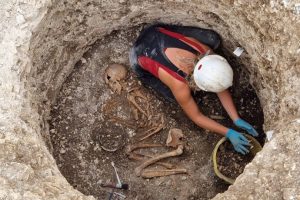It is difficult to say when the ancestors of the present human being acquired what we could call “the human condition”. But without a doubt, adopting the typical upright posture of humans, which contrasts with the habitual stooped posture of apes, is a key element of the human condition.
The first digital reconstruction of the musculature of the legs and pelvis of “Lucy”, the famous fossil specimen of Australopithecus afarensis discovered in Ethiopia in 1974, reveals that it possessed the ability to adopt a posture as upright as that of modern humans.
This revealing digital reconstruction was made by Ashleigh Wiseman of the University of Cambridge in the UK.
Wiseman has modeled the aforementioned musculature in 3D using scans of Lucy’s fossilized skeletal remains.
Australopithecus afarensis was a hominin that lived in eastern Africa more than three million years ago. He was shorter than us, he had the face of an ape, and his brain was smaller than ours. However, it was capable of walking on two legs and adapted to living both in the trees and on the savannah floor, helping the species survive for almost a million years.
Named Lucy after the classic Beatles song “Lucy in the Sky with Diamonds”, this specimen of Australopithecus afarensis is one of the most complete specimens of any Australopithecus type unearthed, with 40% of its skeleton recovered.
![[Img #68830]](https://noticiasdelaciencia.com/upload/images/06_2023/7716_lucy-ya-caminaba-erguida.jpg)
Partial and complete digitization of Lucy’s leg and pelvis musculature. (Image: Ashleigh Wiseman)
Wiseman was able to use recently published open source data on Lucy’s fossil remains to create a digital model of the muscular structure of the 3.2-million-year-old hominin lower body.
Wiseman rebuilt 36 muscles in each leg. Considering Lucy’s height and build, as well as those of a typical modern human, most of Lucy’s muscles were much larger and took up more space in her legs, compared to modern humans.
For example, Lucy’s major calf and thigh muscles were more than twice the size of those of modern humans. This is partly because we have a much higher proportion of fat. Muscles made up 74% of Lucy’s total thigh mass, versus only 50% in modern humans.
Although it has been accepted that Lucy could walk on two legs, it has long been doubted that she was able to walk upright. It was suspected that she was hunched over like chimpanzees. Little by little, the belief that she Lucy walked upright has been gaining strength. And the results of the reconstruction carried out by Wiseman provide conclusive evidence in favor of this theory.
The study is titled “3D volumetric muscle reconstruction of the Australopithecus afarensis pelvis and limb, with estimates of limb leverage”. And it has been published in the academic journal Royal Society Open Science. (Fountain: NCYT by Amazings)












